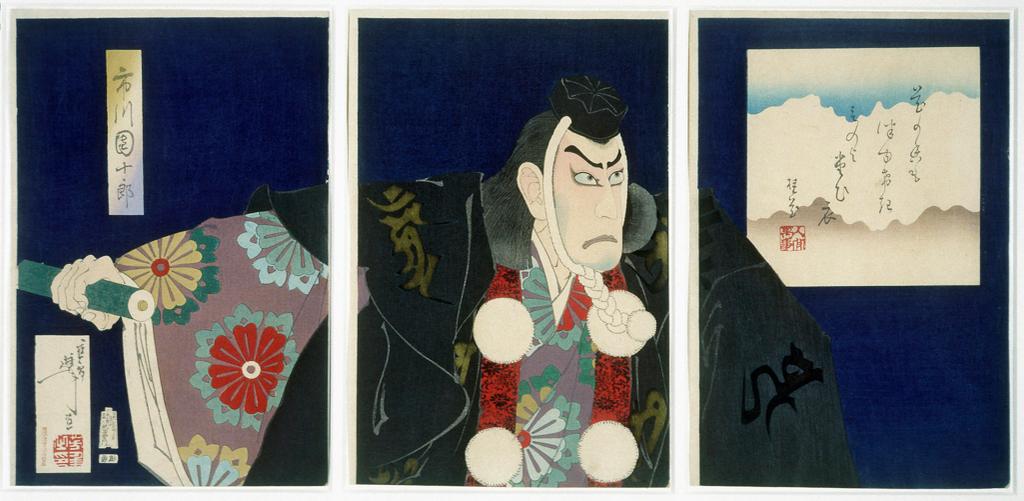Ichikawa Danjûrô IX as Benkei in Kanjinchô

Colour print from woodblocks, with blind embossing (karazuri) and metallic pigment.
Ôban format triptych.
Block-cutter: Hori Yû (Wada Yû).
Poem by Keika.
Publisher: Akiyama Buemon. 01/04/1890.
Keyes 516
The play Kanjinchô (The Subscription Record) was brought to its present form and popularity by the actor portrayed in this print, Ichikawa Danjûrô IX (1839-1903), who was one of the key figures in the move to modernise Kabuki performance in the Meiji era (1868-1911). Like the actor Onoe Kikugorô, who appeared in a print of similar format issued in the same year, Danjûrô was a friend of Yoshitoshi. This print was published in advance of the performance of Kanjinchô at the Shintomi Theatre in Edo from the 22nd of the fifth month of 1890.
The plot is taken from an episode in the life of Minamoto no Yoshitsune and his loyal follower, the warrior-priest Musashibô Benkei at the end of the 12th century. Their story was told in the Heike Monogatari (Tale of the Heike) and the Gikeiki (Story of Yoshitsune), and retold many times in plays and prints.
To escape capture, Yoshitsune and his followers disguise themselves as itinerant priests raising funds for a temple. When they reach the government barrier at Ataka, the suspicious warden demands that Benkei reads the list of donors on the subscription record. Benkei takes out an empty scroll and recites an imaginary list of donors and amounts. The warden is taken in by this ruse, and he allows the party through the barrier. In Yoshitoshi’s print, Benkei is about to unroll the scroll, which he holds in his hand. It is a critical moment of dramatic tension.
The poem by Yoshitoshi’s friend Katsurakuen Keika (1829-99) reads:
‘The flowers and their fragrance like traveller’s robes are wet with dew’ (Hana mo ka mo tsuyukeki mono yo tabigoromo). It is sealed with the poet’s personal motto: ‘Humanity - all things’ (Ningen banji).
In 1890, at the end of his career, Yoshitoshi made five such large-scale half-length portraits of famous Kabuki actors in triptych format; they are generally considered among his masterpieces. This print forms a pair with another published in 01/1890, showing Yoshitoshi’s other great actor friend, Onoe Kikugorô V, in a role from a different play performed in 04/1890.
Given by the Friends of the Fitzwilliam, 2002
P.198-2002




